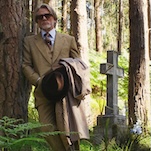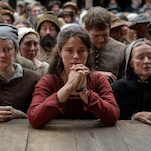Joe Dante, Keith David, and Jello Biafra kick off our coverage of the Fantasia Film Festival
Twenty-two years into its run, the Fantasia International Film Festival is the grande dame of North American genre film festivals. And like any institution, it has its milestones—Fantasia was the first festival to screen Takashi Miike’s work in North America, and arguably launched the J-horror trend internationally—and its traditions, chief of which is the much-discussed meowing that fills the space between when the lights go down and the movie starts up. (That was launched either by a series of short films or a stray cat that snuck into a screening, depending on who you ask.) It also has its veterans, those who have risen through the ranks from volunteers to staff—and sometimes even back again, in the case of one former volunteer coordinator who’s moved on to a new job, but came back this year as a volunteer.
Given all of this, perhaps it’s inevitable that arriving in Montreal for a second year at Fantasia carries with it a sense of déjà vu, from the quizzical look at customs (“what kind of a film festival?”) to the bowl of pommes in the hotel lobby (green, both times). Even the inquiries from Canadians as to the fucked-up state of American politics, delivered over a pint of beer with a furrowed brow and a tone of commiseration at the Irish pub down the street from the theater, feel familiar. (That has changed slightly, given that the festival was forced to pick a new pub after the previous after-hours hangout was damaged in a fire.) But an earnest question over an unpretentious pint speaks to the essence of this particular festival, which may be modest as far as parties and celebrity guests are concerned, but is extremely adventurous in its programming. This is a light year for Fantasia, believe it or not, with a roster of 130 films; those 130 films are spread out over the course of nearly three weeks, as will be our coverage.
The opening weekend of the festival displayed all those seemingly incongruous elements—tradition and adventure, careful curation and sheer overwhelming volume—at once, revolving around a pair of anthology films trading on that old pop culture reliable: name recognition. First was the opening-night premiere of Nightmare Cinema (B-), a sort of sideways revival of the Masters Of Horror franchise from series creator and nicest guy in horror Mick Garris, who had been attempting to turn the concept into a Tales From The Crypt-style horror series, but ended up gathering a few famous friends for an anthology film instead. The ceremony was preceded by a lifetime achievement award for Garris’ friend and collaborator Joe Dante, who quipped, “Getting a lifetime achievement award is nice, but it makes you think your lifetime might be winding down.”
Dante has been on a downward trajectory as a feature filmmaker over the past decade or so (he’s been surprisingly busy in television), but the short-film format and collaborative environment of an anthology seems to have reinvigorated him: His Nightmare Cinema segment, “Mirari”—a winking horror-comedy set in the already-grotesque world of a Los Angeles plastic surgeon’s office—is his best work in years. In a move that suits his bright, unabashedly cartoonish style, Dante stays true to the EC Comics template, using an ethical dilemma as the setup and a nightmarish comeuppance as the punchline to a cruelly ironic joke. In between, Richard Chamberlain makes a scene-stealing appearance as a malevolent plastic surgeon, and prosthetic makeup from KNB Efx Group (the team behind The Walking Dead and the upcoming Predators, among many others) elevates the production value beyond the clearly low-budget sets. Although “Mirari” is nothing groundbreaking, it’s nice to see Dante having fun behind the camera again.
As is the case with all horror anthologies, the rest are a mixed bag. Juan Of The Dead director Alejandro Brugués does his best Dante impression (and it’s a good one) in “The Thing In The Woods,” described by its director as “the third act of a slasher movie” re-contextualized as a standalone short (we skip the kids arriving at the cabin and cut straight to the kills, basically) with a delightfully bizarre sci-fi twist. Downrange director Ryuhei Kitamura, meanwhile, swings for the fences and ends up with a mess with “Mashit,” a riff on ’80s Italian horror set in a Catholic school beset by demons and defended by a fornicating priest-nun duo. And sure, ’80s Italian horror isn’t exactly known for its tight plotting, but all the gleeful excess of the segment can’t make it any more coherent. Hard Candy’s David Slade puts his experience directing all those Black Mirror episodes to wonderfully bizarre use in standout segment “This Way To Egress,” a first-person descent into madness with a masterful command of tone and black-and-white cinematography that heightens the unease. Finally, Garris turns in an unexpected combination of family drama and intense violence in “Dead,” a segment that ekes real tenderness from the friendship between Riley (Faly Rakotohavana) and Casey (Lexy Panterra), teenagers holed up in a hospital ward who are both cursed with the ability to see the dead.
Garris said at the Q&A following the film that he’s hoping to use Nightmare Cinema as a launching pad for lesser-known directors from around the world. It’s a noble goal, but although this edition has some bankable names behind it—besides the directors, Mickey Rourke appears as a hammy Cryptkeeper-type character in an ensemble straight out of cybergoth night at the local fetish club—it’s just too uneven and low budget to make that likely, unfortunately. That uneven quality is not for lack of trying; the below-the-line crew, including music from Full Moon’s Richard Band, is shared across several of the segments, and several of the screenplays even share similar origins, having been cut down from feature-length scripts. (That’s not necessarily a good thing, particularly in Kitamura’s segment.)
Considering how active Garris has been in the horror world these past few years (we’ve covered his Post Mortem podcast in our Podmass feature), we kind of figured we’d see him and his buddies on screen again in some capacity. But we certainly weren’t expecting to see the premiere of Tales From The Hood 2 (C) at this year’s Fantasia. (Recently revived by Universal, the sequel is set for a VOD release in October.) If you’ve seen the original Tales From The Hood, which has become something of a cult classic in the 23 years since its release, you’ll have a good idea of what to expect from this decades-later sequel, which similarly combines progressive social commentary and campy horror fun. How many other horror series—or films in general—can you name that have a giant killer doll and references to Marshall McLuhan and Black Lives Matter?
Keith David of The Thing and They Live fame is clearly relishing his role as the diabolical master of ceremonies, taking over for Clarence Williams III in the original. (Williams is 78 and happily retired.) There’s nothing subtle about David’s red-and-black brocade suit, and the pretense that brings him into the film is utterly absurd: A weapons manufacturer named Dumass Beach (get it?) has hired him to feed a Trumpian RoboCop called the PatriotBot stories of the criminal underworld—tales from the hood, if you will—to refine its law-enforcement abilities. Will that robot eventually go amok and mispronounce its creator’s name as David cackles diabolically in the background? You already know the answer to that one.
In short, Tales From The Hood 2 is silly, low-budget, over-the-top, and a real hoot for those with a soft spot for direct-to-video ’80s and ’90s horror. (Everyone else can comfortably skip it.) The film consists of three comedic stories—highlighted by a segment with Mad Men’s Bryan Batt as a TV psychic/con man who becomes the unwitting vessel for a recently deceased pimp—and one serious segment, “Sacrifice,” in which a black Republican is confronted by the ghosts of victims of racially motivated hate crimes. In a bit of role reversal, Fear Of A Black Hat’s Rusty Cundieff (who also directed quite a few episodes of Chappelle’s Show) takes on the more serious segments, with Menace II Society producer Darin Scott, who’s spent much of his career working on horror cheapies with titles like Megachurch Murder and Something Wicked, handling the more comedic segments. It won’t win any awards for subtlety, but if you’re a fan of the original, you already know that.








































